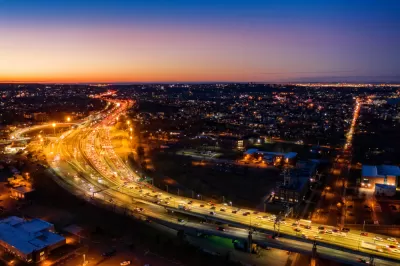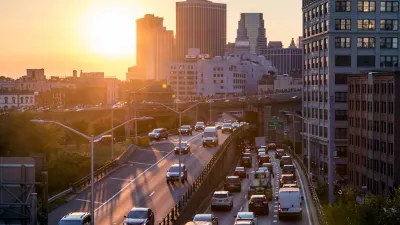New travel patterns and an increased reliance on delivery services and ride-hailing are creating more congestion in New York's outer boroughs.

While Manhattan traffic has seen some relief during the pandemic, other boroughs are experiencing increases in congestion as the pandemic shifts traffic patterns in the city. As Winnie Hu, Patrick McGeehan and Nate Schweber report, "Some neighborhoods are being choked by more vehicles than they have ever seen before, with traffic snarls fueled by a plunge in transit use and car pooling, soaring car ownership and a surge in delivery trucks trying to keep up with an e-commerce boom."
Highways in Brooklyn, Queens, and Staten Island are feeling the pain, with the Brooklyn-Queens Expressway now being the most congested street in the city. Average travel speeds have also fallen on other major arteries. "During the pandemic, Mayor Bill de Blasio, whose time in office ends on Friday, has encouraged people not to drive, and the city has added a significant number of bus and bike lanes. Mr. de Blasio’s successor, Eric Adams, an avid cyclist, has promised to build on those efforts." The new mayor also wants to develop efforts to manage traffic using technology and regulate truck deliveries.
According to former city traffic commissioner Samuel I. Schwartz, the city is "reaching a point where the highway system is overloaded" thanks to increased truck traffic and ride-hailing rides. The congestion has stalled public buses and caused the MTA to shut down or detour certain routes to avoid traffic. "The pandemic has also turned many New Yorkers into car owners as they have abandoned public transit because they’re afraid of the virus or crime."
A proposed congestion pricing scheme designed to discourage driving and reduce traffic has been delayed until at least 2023.
FULL STORY: As Traffic Roars Back, Neighborhoods Outside Manhattan Feel the Pain

Maui's Vacation Rental Debate Turns Ugly
Verbal attacks, misinformation campaigns and fistfights plague a high-stakes debate to convert thousands of vacation rentals into long-term housing.

Planetizen Federal Action Tracker
A weekly monitor of how Trump’s orders and actions are impacting planners and planning in America.

In Urban Planning, AI Prompting Could be the New Design Thinking
Creativity has long been key to great urban design. What if we see AI as our new creative partner?

King County Supportive Housing Program Offers Hope for Unhoused Residents
The county is taking a ‘Housing First’ approach that prioritizes getting people into housing, then offering wraparound supportive services.

Researchers Use AI to Get Clearer Picture of US Housing
Analysts are using artificial intelligence to supercharge their research by allowing them to comb through data faster. Though these AI tools can be error prone, they save time and housing researchers are optimistic about the future.

Making Shared Micromobility More Inclusive
Cities and shared mobility system operators can do more to include people with disabilities in planning and operations, per a new report.
Urban Design for Planners 1: Software Tools
This six-course series explores essential urban design concepts using open source software and equips planners with the tools they need to participate fully in the urban design process.
Planning for Universal Design
Learn the tools for implementing Universal Design in planning regulations.
planning NEXT
Appalachian Highlands Housing Partners
Mpact (founded as Rail~Volution)
City of Camden Redevelopment Agency
City of Astoria
City of Portland
City of Laramie





























